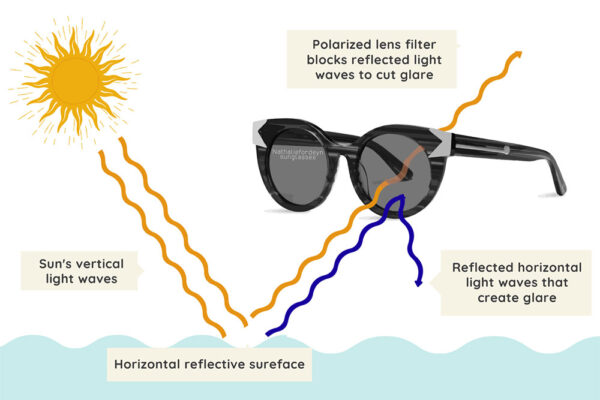Are All Polarized Sunglasses the Same?

Polarized sunglasses are not all the same. The lenses can be made from various materials and construction methods, affecting their quality, performance, and visual clarity. Polarized lenses can be crafted from acrylic, polycarbonate, CR39 (resin), and even mineral glass, each with different production standards. For you, the wearer, this might seem intricate and a bit overwhelming, especially if you’re considering specialized options like glacier sunglasses.
Quick Refresher: Polarized lenses utilize filters that block glare from flat reflective surfaces such as water, snow, or wet roads. If they’re UV400 rated, they provide full ultraviolet protection against the sun’s UVA and UVB rays, which is crucial for any sunglasses frame.
Types of Polarized Sunglasses
There are five main types of polarized sunglasses categorized by their lens material, ranging from low to high quality: acrylic, TAC, polycarbonate, CR39, and mineral glass. Depending on your budget, intended use, and desired performance, you’ll find various options among these lens types.
Type 1: Acrylic Polarized Lenses
Acrylic polarized lenses are known for their affordability, making them an entry-level option for those seeking polarized performance without a significant investment. These lenses are mass-produced by integrating a polarized film between two layers of acrylic material. While cost-effective, acrylic lenses are more susceptible to scratches and can exhibit peripheral distortion, particularly around the edges. They are best for general everyday use and casual activities, but less ideal if you prioritize clarity and durability.
Type 2: TAC Polarized Lenses
TAC (Tri Acetate Cellulose) polarized lenses are popular for their lightweight properties and multi-layer construction. Comprising multiple layers, including anti-scratch, anti-reflective, and UV protection, TAC lenses offer superior optical clarity and are designed for sports-oriented frames. While they cannot be made as prescription lenses, they outperform acrylic in clarity and protection against UV light, making them a solid choice for casual outdoor use.
Type 3: Polycarbonate Polarized Lenses
Polycarbonate polarized lenses are favored for their durability and impact resistance, making them ideal for athletes and outdoor enthusiasts. They are constructed through an injection-molding process that ensures robustness. Lightweight yet strong, polycarbonate lenses offer significant UV protection, although they may present some optical distortion. These lenses are highly recommended for sports and activities requiring high durability.
Type 4: CR39 Polarized Lenses
CR39 polarized lenses are celebrated for their clarity, achieved through a laminating process that minimizes distortions. While not as impact-resistant as polycarbonate lenses, they provide excellent scratch resistance and are suitable for everyday use. CR39 lenses strike a balance between performance and optical excellence, making them a preferred choice for casual wear.
Type 5: Glass Polarized Lenses
Mineral glass polarized lenses represent the pinnacle of optical performance. They offer unmatched clarity and superior scratch resistance, providing excellent glare reduction in bright conditions. However, they tend to be heavier and less durable compared to plastic lenses, making them less ideal for high-impact activities. Glass lenses are best for daily wear, driving, and outdoor activities where visual precision is key.
Choosing the Right Polarized Lens Material
When selecting the right polarized lens material, consider these factors to enhance your vision and suit your lifestyle:
Durability:Assess how resistant the lens material is to impacts and scratches, especially if you lead an active life.
Weight: Lightweight materials like polycarbonate offer comfort for extended wear.
Optical Clarity: High clarity is essential for precision activities, with CR39 being prevalent for everyday use.
UV Protection: Ensure lenses are rated UV400 for maximum UV protection.
Cost: Prices vary widely, so consider your budget.
Aesthetic Preferences: Some coatings, like mirrored lenses, can impact the style of the sunglasses.
By weighing these factors, you can select a polarized lens material that meets your vision needs and lifestyle.
Choosing Between Polarized Lens Colors
The lens color in polarized sunglasses significantly impacts both style and functionality. Different colors enhance visibility, contrast, and depth perception in varying light conditions, making it essential to choose the right color for your activities.
Gray Polarized Lenses: Versatile and suitable for various conditions, they maintain true color perception while reducing brightness, ideal for driving and outdoor use.
Brown Polarized Lenses: Enhance contrast and depth perception, making them excellent for activities like fishing and golfing.
Green Polarized Lenses: Offer a natural color balance and reduce glare, perfect for driving and outdoor sports.
For specific sports needs, such as glacier sunglasses for snowy conditions, consider specialized tints that can improve visibility and contrast.
Key Takeaways
Acrylic: Affordable, moderate durability, best for casual use.
TAC: Great for everyday use, non-prescription, and light sports.
Polycarbonate: Lightweight and impact-resistant, perfect for active lifestyles.
CR39: Clear optics for everyday wear, lighter than glass.
Glass: Superior clarity and scratch resistance, ideal for low-impact situations.
Gray, Brown, Green Polarized Lenses: Each serves unique functions, enhancing vision and comfort in different activities.
By understanding the differences in polarized sunglasses, you can make an informed choice that aligns with your needs, whether you’re looking for a stylish pair for everyday wear or specialized glacier sunglasses for snowy adventures.





